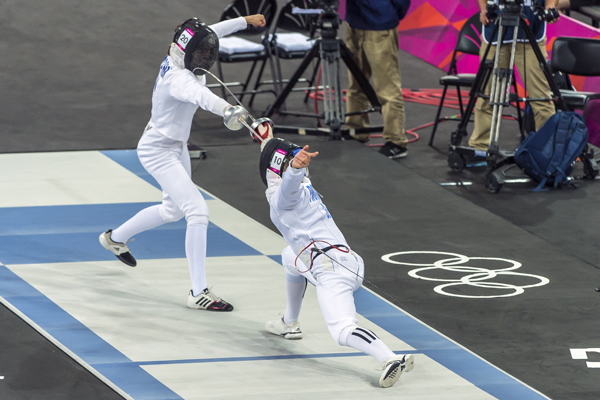Photo courtesy of Paul ApSimon
Fencing, Chinese boxing, swimming, and walking are great indoor activities
Yes, it’s been a long and cold winter. For some (including this writer), the temptation to sit inside, eat chips, and stream online TV shows is still overwhelming. But whether you kept active or turned into a couch potato, the Fulcrum has collected a few suggestions of enjoyable activities that will help get you moving again before spring.
Fencing
“Fencing is a super technical sport but people don’t often get injured while doing it,” says Paul ApSimon, fencing coach for the University of Ottawa Gee-Gees.
Fencing is a dynamic sport. It is like ancient sword fighting except it uses lightweight swords and contestants are well padded. It’s also a plyometric exercise, with many stops and bounding directions.
“Fencing has a lot of fitness benefits. One of the things people lose later in life is stability,” says ApSimon. “Fencing is always done in seated stance, or a half squat. We also use a ton of core work, which on its own has a lot of benefits for stability and balance.”
Before their first fight, ApSimon says people need to condition themselves by developing power, speed, and balance. Otherwise, you’re looking at being gassed after only a few minutes of work.
“You really get into (fencing),” says ApSimon. “After a while of having someone with a weapon in front of you, you step back and realize how much work you’ve done.”
Chinese boxing
Chinese boxing is Chinese martial arts without the trendy North American name. Sinisa Gajic, owner of Practical Chinese Boxing in the Glebe, says martial arts take the balanced approach to fitness over the fast one, resulting in less disappointment and injury.
“Martial arts are no boot camp. We are not looking for maximum fitness. We lead people to gradual fitness and skill development over time,” says Gajic.
Martial arts can be practised at any age or skill level. To get fit, Gajic says people should be prepared to dedicate about an hour per day toward focused exercise with proper form, no distractions, and a goal in mind. The first lesson Gajic teaches his clients is how to use breath as a means of relaxing and increasing energy.
“People are often already stressed. Pushing yourself to your limits all the time is counterproductive,” he says. “Many people look for activities that increase tension on their body. I think we are already tense because of all the stress in our daily lives. So you want to relax when you train.”
Swimming
According to Steve Papai, recreation supervisor for Brewer Pool, swimming is a great cardio workout that’s also generous on the joints.
“Swimming improves fitness levels because it uses breath control. You’re more buoyant in the water so it is easy on joints,” he says.
Swimming is also great for overall toning, as it works your body out from neck to toe.
Aside from the fitness benefits of swimming, Papai says a lot of people enjoy the social benefits of having a pool membership, and luckily, all students have access to the Montpetit pools.
Walking
Walking is the most common physical activity but, according to Statistics Canada, we don’t do enough of it. 41 per cent of Canadians walk less than one hour per week, but the Canadian Community Health Survey advises that to keep moderately active, one should do at least 30 minutes to an hour of walking per day.
The Canadian Centre for Occupational Health and Safety recommends more walking to help improve mental health, lower blood pressure and cholesterol, ease back pain, and reduce risk of heart disease and stroke. Also, adding on at least an extra 30 minutes of walking per day will help you lose about five kilograms of fat per year.





